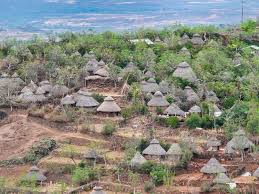The Ethiopian Ministry of Education has taken a significant step in the realm of education by introducing a new and comprehensive Grade 11 textbook. This textbook, authored by renowned experts in the field, offers a wealth of knowledge and resources for students eager to explore biology and related sciences. In this article, we will delve into the details of this textbook and provide you with a direct link to download the PDF version.
39 MB
Meet the Authors and Contributors
Before we dive into the content, it’s essential to acknowledge the brilliant minds behind this textbook:
- Writers:
- Habtamu Wodaj, PhD
- Sutuma Edessa, PhD
- Pedagogical Editor:
- Meskerem Cheru, MSc
- Content Editor:
- Destaw Damtie, PhD
- Language Editor:
- Yenus Nurie, PhD
- Illustrator:
- Nega Tassie, PhD
- Designer:
- Ali Seid, PhD
- Evaluators:
- Berhanu Te faye, MA & MEd
- Gebrehana Zeleke, MSc
- Samuel Desalegn, MSc
- Bekele Geleta, MSc
This team of experts has collaborated to create a textbook that promises to be a valuable resource for Grade 11 students and educators alike.
Exploring the Textbook’s Contents
The Grade 11 textbook is divided into several units, each focusing on a different aspect of biology and related subjects. Here is an overview of the contents you’ll find within:
Unit One: Biology and Technology
- Learning from nature
- Biology and technology
- The benefits of biology to technology
- Uses of technology in biology
- Impacts of biology and technology on society and the natural world
- Impacts of biology on society and the natural world
- Impacts of technology on society and the natural world
- Ethical issues in biology
- Ethical treatment of plants and animals during biological studies
Unit Two: Animals
- Characteristics of animals
- Invertebrates and Vertebrates
- Invertebrate Animals
- Vertebrate Animals
- Reproduction in Animals
- Asexual reproduction in animals
- Sexual reproduction in animals
- Reproduction in various species
- The economic importance of animals (insects)
- Beneficial aspects of insects
- Harmful aspects of insects
- Animal Behavior
- Types of Animal Behavior
- Patterns of Behavior
- Homeostasis in animals
- Thermoregulation
- Osmoregulation
- Blood Sugar Regulation
- Control of homeostasis
- Renowned zoologists in Ethiopia
Unit Three: Enzymes
- What are enzymes?
- Properties and functions of enzymes
- General properties of an enzyme
- The function of enzymes
- Protein structures
- Enzyme-substrate models
- Enzyme-substrate binding models
- Enzymatic transition state
- Enzyme regulation
- Types of enzymes
- Enzyme structural classification
- Basic classification of enzymes
- Factors affecting enzyme action
- Enzyme kinetics
- Application of enzymes in industries and their benefits
- Uses of enzyme application
- Malting in Ethiopian tradition
- Steps of modern malting
- Traditional malting for local alcohol production
- Renowned Biochemists in Ethiopia
Unit Four: Genetics
- The genetic materials
- The structure and function of DNA and RNA
- The Structure and function of DNA
- DNA replication
- The structure and function of RNA
- The process of cell division
- Cell Division
- Protein synthesis
- Mendelian inheritance
- Mendelian crosses
- Monohybrid cross
- Dihybrid Cross
- Test Crosses
- Sex determination
- Non-Mendelian inheritance
- Co-dominance, Incomplete dominance and Multiple alleles
- Rh factor inheritance in humans and its medical importance
- Sex-linked inheritance in humans
- Environmental effects on phenotype
- Human pedigree analysis and its importance
- Genetic disorders
- Genetic testing and counseling
- Gene therapy
- Breeding
- Indigenous knowledge of Ethiopian farmers
- Bioinformatics introduction
Unit Five: The human body systems
- Human Musculoskeletal Systems
- Types of muscles
- Mechanism of actions of skeletal muscles
- The human axial and appendicular skeletons
- Joints
- The reproductive system
- Human reproductive system (Male and Female)
- Gametogenesis
- Positive and negative feedbacks to control the menstrual cycle
- Fertilization and pregnancy
- Mechanism of action of contraceptives
- Causes of infertility in humans
- The major sexually transmitted infections (STIs) in Ethiopia
- Epidemiology of STIs in Ethiopia
- Harmful traditional practices
- Harmful traditional practices
- Family planning
- Risks related to the lack of family planning
- Family planning actions
- Family planning services
- Effects of alcohol use, chewing Khat, cannabis, and other drug uses on STIs transmission and unwanted pregnancy
- The effects of alcohol uses
- Effects of chewing Khat
- Effects of drug uses
Unit Six: Population and natural resources
- Population size, density, and dispersal
- Exponential and logistic growth in populations
- Demographic structure
- Population regulation
- Natural resources
- Renewable
- Non-renewable
- Conservation of natural resources in Ethiopia
- Impact of traffic accidents on wild and domestic animals
- Impact of human activities on the environment
- Climate change
- Global warming
- Ozone layer depletion
- Acid rain
- Loss of Biodiversity
- Toxic bioaccumulation
- Resource depletion
- Indigenous conservation practices in Ethiopia
Download the Grade 11 Textbook
Now that you have a comprehensive overview of the textbook’s content, you may be eager to explore it further. To access the PDF version of this Grade 11 textbook, please click here.
This textbook is a valuable resource for students, educators, and anyone interested in biology, genetics, and the natural world. Make the most of this opportunity to expand your knowledge and understanding of these fascinating subjects. Happy learning!





